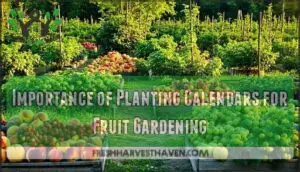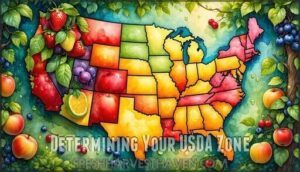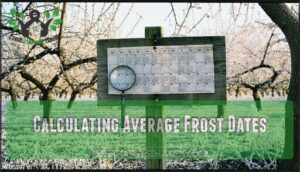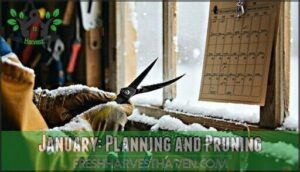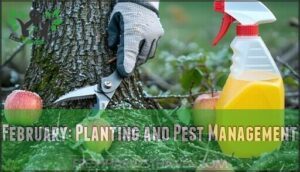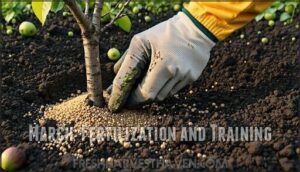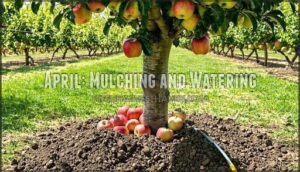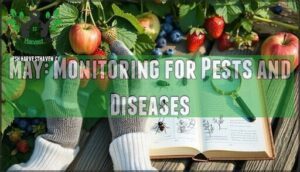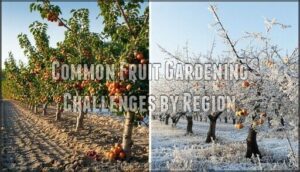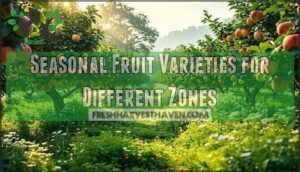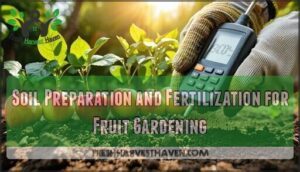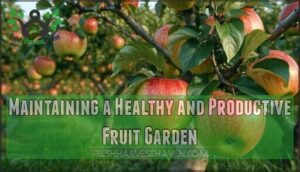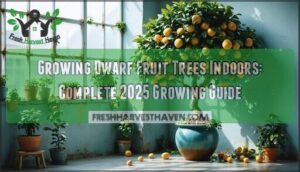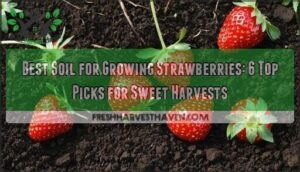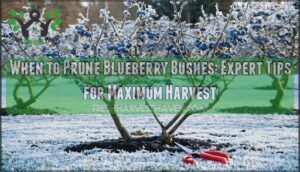This site is supported by our readers. We may earn a commission, at no cost to you, if you purchase through links.
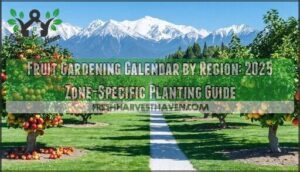 Your fruit gardening calendar by region depends on your USDA hardiness zone and local frost dates.
Your fruit gardening calendar by region depends on your USDA hardiness zone and local frost dates.
Northern zones (3-5) plant in spring after ground thaws, while southern zones (8-10) favor fall or winter planting.
Each zone has specific timing for pruning, fertilizing, and harvesting. You’ll need to match your tasks to your area’s growing season length and weather patterns.
A zone-specific calendar prevents costly mistakes like frost damage or heat stress that can ruin entire harvests.
The difference between abundant fruit and disappointing losses often comes down to perfect timing. Understanding your region’s unique seasonal rhythms reveals the secrets to consistent harvests year after year.
Table Of Contents
- Key Takeaways
- Regional Fruit Gardening by Month
- Importance of Planting Calendars for Fruit Gardening
- Finding Your Hardiness Zone and Frost Dates
- Creating a Fruit Gardening Calendar for Your Zone
- Fruit Gardening Tasks by Month
- Common Fruit Gardening Challenges by Region
- Seasonal Fruit Varieties for Different Zones
- Soil Preparation and Fertilization for Fruit Gardening
- Maintaining a Healthy and Productive Fruit Garden
- Frequently Asked Questions (FAQs)
- What is a planting calendar?
- How can I find a planting guide or calendar?
- Why do I need a local planting calendar?
- How do I create a localized planting calendar?
- How do urban gardeners use localized planting calendars?
- When should you plant fruit trees?
- . Why Should You Start Seeds indoors?
- . Which Seeds Should You Start indoors?
- . When Should You Start Seeds indoors?
- . When Should You Transplant seedlings?
- Conclusion
Key Takeaways
- Know your USDA hardiness zone and frost dates – You’ll need these basics to time planting, pruning, and harvesting correctly for your specific location and avoid costly mistakes like frost damage.
- Follow zone-specific timing for major tasks – Your pruning, fertilizing, and planting windows differ dramatically between northern zones (3-5) and southern zones (8-10), so generic advice won’t work.
- Account for your property’s microclimates – You can’t rely on zone averages alone since buildings, elevation, and sun exposure create warmer or cooler pockets that affect when you can safely plant.
- Adapt your calendar based on actual conditions – You’ll need to adjust your schedule when weather patterns shift, pest outbreaks occur, or your specific varieties perform differently than expected.
Regional Fruit Gardening by Month
Your fruit garden’s success depends on timing tasks with your region’s unique climate patterns.
Each hardiness zone has specific months when planting, pruning, and harvesting work best, turning seasonal changes into your garden’s advantage.
Understanding Seasonal Variations
Success in fruit gardening hinges on understanding seasonal variations that shape your growing strategy throughout the year. Each season brings unique Climate Impacts that directly affect when you plant, prune, and harvest your fruit trees.
Your fruit gardening calendar should reflect these natural rhythms. Here’s how to master seasonal variations:
- Track frost dates specific to your hardiness zone for precise timing
- Document flowering patterns of regional fruit varieties year over year
- Monitor Microclimate Effects within your property boundaries
- Adjust planting seasons based on observed weather patterns
Regional climate gardening isn’t just about following a generic schedule—it’s about reading your landscape’s unique story. Seasonal Challenges like unexpected late frosts or early heat waves require flexible Regional Adaptations in your approach.
To further enhance your garden’s resilience, consider how mulching retains soil moisture and regulates temperature. When you align your efforts with nature’s cycles, you’ll extend growing seasons and improve harvests.
Think of Variety Selection as choosing the right players for your climate team—each fruit performs best under specific conditions.
Adapting to Local Climate Conditions
Your local climate conditions make or break your fruit gardening success. Understanding your specific environment helps you work with nature instead of fighting it.
| Climate Factor | Adaptation Strategy |
|---|---|
| Temperature swings | Choose cold-hardy varieties |
| Rainfall patterns | Adjust seasonal watering schedules |
| Soil composition | Apply regional soil amendments |
| Local pests | Implement targeted pest control |
Microclimate management starts with observing your yard’s unique conditions. That sunny south-facing slope might support citrus while your shaded north corner suits berries. Your fruit gardening calendar should reflect these realities.
USDA hardiness zones provide the foundation but your backyard tells the real story. Frost dates vary within zones so track your specific area’s patterns. Regional fruit varieties perform better than generic options because they’ve adapted to local conditions. This is crucial for successful gardening and requires an understanding of your local climate and microclimate management.
Zone-Based Gardening Approaches
Most gardeners underestimate how much their USDA hardiness zone differs from their backyard’s actual conditions. Your fruit gardening calendar needs zone-specific adjustments that go beyond the basic map.
Microclimate management starts with understanding your property’s unique conditions. The key steps include:
- Track weather pattern tracking data to spot seasonal shifts that affect your regional planting guide
- Use local climate guides to select fruit varieties that thrive in your specific conditions
- Adjust your gardening calendar by zone based on actual temperatures, not just zone averages
Smart regional fruit selection transforms climate challenges into gardening advantages through targeted gardening by region strategies.
Importance of Planting Calendars for Fruit Gardening
You’ll transform your fruit gardening success when you follow a proper planting calendar that’s customized to your specific zone and frost dates.
A well-planned schedule helps you avoid costly mistakes like planting too early and losing crops to unexpected frosts, while also ensuring you don’t miss the ideal planting windows that lead to your best harvests.
Benefits of Timely Planting
Getting timing right puts your fruit garden on the fast track to success.
Your fruit gardening calendar shows exactly when to plant fruit for maximum results in your region.
- Increased Yield – proper timing guarantees strong root systems before growing season peaks
- Enhanced Flavor – fruit develops full taste when planted at ideal regional planting guide dates
- Reduced Disease – strategic timing avoids vulnerable periods when pests thrive
- Extended Harvest – staggered planting based on fruit harvest times delivers continuous production
Better growth happens when you follow timely planting schedules suited to your zone’s unique conditions.
Avoiding Frost Damage and Pests
Proper timing protects your fruit trees from nature’s two biggest threats.
Frost protection methods like row covers and mulch around tree bases shield young plants when temperatures drop unexpectedly.
Your fruit gardening calendar should include frost dates to schedule protective measures before damage occurs.
Pest identification becomes easier when you understand seasonal pest cycles.
Spring aphids differ from summer scale insects, so timing your natural pest control efforts matters.
Regular inspections catch problems early, while proper pruning improves airflow for disease prevention.
Pest control fruit trees need consistent attention throughout growing seasons.
Maximizing Fruit Yield and Quality
Success breeds success when your fruit gardening calendar synchronizes with nature’s rhythms.
Following a regional planting guide transforms scattered efforts into purposeful action that delivers consistent harvests year after year.
To maximize fruit yield and quality through strategic timing:
- Schedule ideal pollination windows by planting compatible varieties that bloom simultaneously and implementing targeted pest control during critical flowering periods
- Coordinate soil health maintenance with fruit tree fertilizer applications timed to your zone’s growing season while practicing pruning techniques that encourage productive growth
Your variety selection matters most when it aligns with regional conditions.
Like a well-tuned orchestra, every garden task performs better when properly scheduled.
Smart gardeners know that timing beats technique every time.
Finding Your Hardiness Zone and Frost Dates
Before you plant your first fruit tree, you’ll need to know your exact hardiness zone and frost dates.
These two pieces of information determine when it’s safe to plant and what varieties will thrive in your specific location.
Determining Your USDA Zone
Why stumble through fruit gardening when you can discover success with your USDA hardiness zone? This climate roadmap determines which fruits flourish in your area and when to plant them.
Finding your zone is simple. Use the USDA hardiness zone map and enter your zip code into any zone lookup tool online. You’ll instantly discover your zone number based on average annual minimum winter temperatures.
Don’t ignore microclimate impact on your property. Buildings, water features, and elevation create pockets that run warmer or cooler than surrounding areas. These regional variations matter more than you’d think.
Check for 2024 map updates since climate patterns shift over time. Some locations fall into overlap areas, giving you flexibility with plant choices.
Once you know your zone, you’re ready to create a regional planting guide that works. Your fruit gardening calendar depends on understanding these frost dates and zone boundaries. It’s like having a GPS for your garden—you’ll never get lost again.
Calculating Average Frost Dates
Once you’ve identified your USDA hardiness zone, calculating average frost dates becomes your roadmap to successful fruit gardening. Frost Date Averages from reliable Data Sources help you nail down your regional gardening calendar.
Here’s your action plan:
- Check Historical Trends from local weather stations spanning 10+ years
- Factor in Microclimate Impact around your specific garden location
- Verify dates with your county extension office for Planting Adjustments
Don’t wing it with guesswork. Your frost dates determine when tender fruit trees can safely go in the ground and when you’ll need protection for established plants. This planting calendar foundation prevents costly mistakes and maximizes your harvest window.
Creating a Fruit Gardening Calendar for Your Zone
Once you know your hardiness zone and frost dates, you can create a customized fruit gardening calendar that works perfectly for your specific location.
This calendar becomes your roadmap for timing everything from planting new fruit trees to harvesting your homegrown bounty.
Zone 8 Fruit Gardening Calendar
Now you can create a thorough fruit gardening calendar that matches your Zone 8 climate. Your frost dates typically range from February 22 to April 1 for the last frost and October 30 to December 1 for the first frost.
This gives you about 240 frost-free days to work with. Variety selection becomes your first priority. Choose apples like Anna and Dorsett Golden that need fewer chill hours (800-1000 hours) than northern varieties.
Your planting calendar should focus on January through March for bare-root trees when they’re dormant. Pruning techniques work best in January and February before buds break.
Pest control starts early since your mild winters don’t kill all insects. Irrigation needs vary by season but expect to water deeply during summer heat stress periods.
Your regional fruit varieties like Celeste figs and Santa Rosa plums handle Zone 8’s temperature swings better than tropical fruits. With the long growing season, succession planting is also a viable option.
Zone 9 Fruit Gardening Calendar
Zone 9’s nearly year-round growing season opens doors to exciting fruit gardening opportunities you can’t find in colder regions.
Your planting calendars should focus on January through March for bare-root installations, while April through June emphasize irrigation needs and pest control strategies.
Here’s what makes Zone 9 special for fruit gardening:
- Citrus varieties like Meyer lemons and kumquats thrive with minimal winter protection
- Avocado cultivation succeeds when you choose cold-hardy varieties like Hass
- Tropical fruits including figs, pomegranates, and guavas produce abundant harvests
- Regional fruit varieties expand your options with loquats and passion fruit.
Summer months demand consistent watering systems and mulching around trees. Your USDA hardiness zone allows for zone-based gardening strategies that maximize production.
Fall brings maintenance tasks like pruning and fertilizing. For example, September is a good time to fertilize citrus trees using balanced fertilizer. A well-planned fruit gardening calendar guarantees your subtropical paradise delivers impressive yields year after year.
Adjusting The Calendar for Microclimates
Your fruit gardening calendar isn’t complete without adjusting for your property’s unique microclimates. These small-scale climate variations can make or break your harvest success.
Even neighboring yards experience different conditions that affect timing and plant selection. Your garden likely contains several distinct microclimates that require specific attention:
- Sun Exposure variations create warm spots perfect for heat-loving citrus
- Wind Protection areas shield delicate blossoms from damaging gusts
- Soil Temperature differences affect root development and planting timing
- Water Runoff patterns influence irrigation needs and plant placement
- Urban Heat islands extend growing seasons in developed areas
Smart gardeners map these microclimates and adjust their fruit gardening calendar accordingly. This climate adaptation approach transforms generic regional gardening tips into precise schedules. Your customized gardening calendar adjustments turn challenging conditions into advantages, maximizing both fruit quality and yield.
Fruit Gardening Tasks by Month
You’ll find that breaking down fruit gardening into monthly tasks keeps your garden thriving year-round without overwhelming your schedule.
Each month brings specific opportunities to nurture your fruit trees and bushes, from winter pruning to summer pest monitoring, which helps in maintaining a healthy garden throughout the year with complete concepts in mind.
January: Planning and Pruning
Winter’s dormant season brings your fruit trees into their most manageable state for essential maintenance. January’s cold grip creates the perfect window for tool maintenance and strategic pruning techniques that’ll shape your harvest success. Your fruit gardening calendar centers around this pivotal month when trees sleep deeply.
Sharp, clean tools prevent disease spread between cuts. Inspect your pruning shears, loppers, and saws now. Oil the hinges and sharpen blades for precise cuts that heal quickly. This orchard layout review time lets you walk your property and plan improvements without leaves blocking your view.
Dormant spraying follows pruning to eliminate overwintering pests and diseases. Apply horticultural oil on calm days above 40°F. Your USDA hardiness zone determines which pests to target specifically.
Essential January tasks include:
- Variety selection research for spring planting additions
- Fruit tree pruning of dead, diseased, or crossing branches
- Planting calendar finalization based on your zone’s frost dates
Think of January as your fruit garden’s strategic planning session. You’re setting up dominos that’ll fall perfectly into place come spring. For larger branches, consider investing in specialized pruning equipment.
February: Planting and Pest Management
Building on January’s planning efforts, February transforms your fruit gardening calendar into action with dormant pruning and strategic pest prevention.
This month’s the sweet spot for tool maintenance – sharpen and sanitize pruners to prevent disease spread between cuts.
Dormant pruning works best on mature apple and pear trees when they’re still sleeping. Make clean cuts at 45-degree angles, removing dead or crossing branches. Your fruit tree pruning skills will shine here.
Apply dormant oil spray when temperatures hit 45°F without freezing for 24 hours. This tackles overwintering pests like scale and mites before they wake up hungry. Think of it as pest control while they’re still groggy. Consider using a quality brand selection for best results.
Early planting opportunities emerge in zone 9, where soil amendments can warm the ground. Mix organic compost into planting areas now.
Zone 8 gardeners should continue frost protection for tender plants.
Remove mummy berries from blueberry bushes to reduce disease pressure. Set preventative traps and monitor for early pest signs. Your pest management strategy starts now, making summer harvests more rewarding.
March: Fertilization and Training
March brings new life to your fruit trees as they shift from dormancy to active growth. This critical window sets the foundation for a successful harvest season through strategic fertilization and training methods.
Essential March Tasks:
- Apply balanced fertilizer when buds swell but before blooms open – use 10-10-10 NPK at ½ pound per inch of trunk diameter, spread at the drip line for maximum root uptake
- Complete training techniques like limb spreaders and apple bands to establish strong branch structure while wood remains flexible
Your fruit gardening calendar should prioritize fertilizer types that match your soil’s needs. Think of fertilization as breakfast for your trees – they’re waking up hungry after winter’s fast. Bloom boosters can enhance flowering, but timing matters more than strength.
Pruning timing wraps up early this month before sap flows heavily. Training methods work best now because branches bend easily without breaking. Grafting techniques also succeed in March’s mild temperatures.
Focus on fruit tree care fundamentals: proper nutrition and structural support. These fruit tree maintenance steps guarantee your trees develop the framework needed for heavy fruit loads later.
April: Mulching and Watering
Throughout April’s warm embrace, you’ll shift from fertilizing to perfecting your fruit tree watering and mulching system.
Apply mulch types like wood chips or straw 2-3 inches deep, keeping material away from trunks to prevent rot.
Different mulch types offer varying benefits for your fruit gardening calendar.
Monitor soil moisture weekly and adjust watering techniques based on regional gardening conditions.
Proper fruit tree watering and mulching guarantees healthy root development while maximizing water conservation throughout the growing season.
May: Monitoring for Pests and Diseases
May transforms your garden into a battlefield where vigilance becomes your greatest weapon. As temperatures rise, pest activity intensifies, making pest monitoring essential for protecting your fruit harvest.
Effective Pest Identification starts with knowing your enemy:
- Check leaves weekly for discoloration, holes, or sticky residue that signals trouble
- Examine undersides of leaves where pests often hide their eggs
- Focus on new growth since it’s most vulnerable to attacks
- Document findings in your garden journal for future reference
Disease Prevention requires prompt action when you spot problems. Remove infected plant parts immediately and dispose of them away from your garden. Don’t compost diseased material—it’s like inviting trouble back next season.
Organic Controls like neem oil offer safer alternatives to harsh chemicals. Introducing beneficial insects such as ladybugs creates natural pest management without harming your family or environment.
Integrated Management combines multiple strategies for thorough disease monitoring. Establish Spray Schedules based on your observations rather than calendar dates. This targeted approach transforms potential pest issues into manageable challenges, ensuring your fruit garden thrives.
Common Fruit Gardening Challenges by Region
Different regions create unique challenges that can test even experienced fruit gardeners.
Zone 8 gardeners face unpredictable late frosts that damage blossoms and summer heat stress that reduces fruit quality.
Zone 9 growers battle extended drought periods and increased pest pressure from year-round warm temperatures.
Zone 8 Challenges: Frost and Heat Stress
Zone 8 gardeners face a climate rollercoaster that keeps you on your toes.
Your fruit gardening calendar must account for frost dates ranging from February to March, plus summer heat that can hit 104°F.
Frost mitigation starts with mulching and strategic watering before cold snaps hit.
Heat-tolerant fruits like figs and citrus handle scorching better than delicate varieties.
Microclimate management becomes your secret weapon—use shade cloth and proper spacing to create cooler zones.
Smart watering strategies and sun protection help your trees survive both extremes in this challenging USDA hardiness zone.
Zone 9 Challenges: Drought and Pests
Zone 9 gardeners face unique hurdles, but smart planning transforms obstacles into opportunities.
Your fruit gardening calendar must account for intense heat and persistent pests that thrive in warm climates.
Here’s your survival strategy:
- Install drip irrigation systems for precise water conservation
- Choose drought-tolerant fruits like figs, pomegranates, and persimmons
- Select pest-resistant varieties that withstand local challenges
- Implement natural pest control using beneficial insects and companion planting
- Master soil moisture management through mulching and organic matter
Success depends on understanding your USDA hardiness zone’s specific demands and adapting accordingly.
Strategies for Overcoming Regional Challenges
While drought and pests challenge Zone 9 gardeners, smart region-specific strategies can turn these obstacles into manageable tasks. Your fruit gardening calendar should include proven climate-specific practices that work with your local climate conditions.
Microclimate Management starts with understanding your yard’s unique conditions. Plant heat-sensitive varieties in morning sun spots and drought-tolerant types in exposed areas. Water Conservation through drip irrigation and thick mulch layers keeps roots happy while cutting water bills in half.
Variety Selection matters more than you’d think. Choose fruits bred for your region’s challenges—like drought-resistant figs or pest-resistant citrus varieties. Soil Amendments with compost improve water retention and feed beneficial microbes that fight harmful pests naturally.
Pest Adaptation means working smarter, not harder:
- Install beneficial insect hotels near fruit trees for natural pest control
- Use reflective mulch around plants to confuse flying pests and reduce heat stress
- Schedule deep watering sessions during cooler evening hours to maximize absorption
These regional adaptations create resilient gardens that thrive despite challenging conditions.
Seasonal Fruit Varieties for Different Zones
Choosing the right fruit varieties for your zone and season makes the difference between a thriving orchard and a disappointing harvest.
Your success depends on matching each fruit’s specific needs to your local climate patterns and growing windows, which is crucial for a thriving orchard.
Winter Fruit Varieties for Zone 8
Building on regional challenges, you’ll find winter fruit varieties perfectly suited to Zone 8’s unique conditions.
Cold hardiness becomes your best friend when selecting fruits that can handle those unpredictable late frosts. Your fruit gardening calendar should prioritize varieties that meet specific dormancy needs.
Chill hours determine whether your trees will actually produce fruit—most need 150-1,000 hours below 45°F during winter months. Variety selection matters tremendously for zone-based gardening success.
Smart choices transform winter from a gardening dead zone into productive months.
| Winter Fruit Varieties | Cold Hardiness | Harvest Period |
|---|---|---|
| Satsuma Mandarins | 15-20°F | December-February |
| Meyer Lemons | 20-25°F | December-April |
| Hardy Figs (Celeste) | 10-15°F | Late fall |
| Pomegranates (Wonderful) | 10°F | October-January |
Your USDA hardiness zone determines which winter fruit varieties will thrive. These hardy champions laugh at Zone 8’s occasional cold snaps while delivering fresh fruit when grocery store options disappoint.
Spring Fruit Varieties for Zone 9
Zone 9’s spring climate creates perfect conditions for diverse fruit tree care and planting.
Your garden can flourish with strategic citrus selection and proper USDA hardiness zone planning.
Spring fruit varieties thrive when you match plants to local conditions. Here’s your zone-based gardening blueprint:
- Citrus Selection: Meyer lemons and Owari satsumas handle occasional cold snaps while delivering zesty harvests
- Stone Fruits: Low-chill peaches like Red Baron and Santa Rosa plums need minimal winter chilling hours
- Berry Varieties: Strawberries fruit by May, while southern highbush blueberries tolerate warmer temperatures beautifully
- Tropical Options: Pomegranates and loquats set fruit reliably in spring’s moderate heat
Plant after March 1st when frost danger passes.
These tropical options and grafting techniques help extend your harvest window naturally.
Summer Fruit Varieties for Both Zones
Summer’s heat opens up exciting possibilities for Heat-Tolerant Fruits in both zones 8 and 9. You’ll want to focus on stone fruits like peaches, plums, and nectarines that actually love the warmth. Pest-Resistant Varieties of blackberries and raspberries handle summer stress better than you’d expect.
Don’t forget about melons – watermelons and cantaloupes are perfect summer fruit varieties that thrive in hot conditions. Watering Summer Fruits becomes your main job, especially for citrus trees that need consistent moisture.
Ripening Timeframes vary, but most fruit varieties peak in July and August. Summer Pruning helps manage growth and improves air circulation.
Your fruit growing guide should emphasize morning watering and afternoon shade for sensitive plants. With proper fruit tree care and attention to your planting calendar, you’ll harvest sun-sweetened treasures all season long.
Fall Fruit Varieties for Both Zones
After summer’s bounty winds down, fall brings exciting harvest opportunities in both zones.
Your fruit growing guide should focus on these Late-Season Apples and Pear Variety Selection strategies:
- Plant Cold-Hardy Figs that’ll survive winter’s bite in zone 8
- Schedule Fall Berry Harvest timing for maximum sweetness
- Begin Autumn Citrus Care routines before cold snaps arrive
- Implement fruit tree maintenance schedules for dormant season preparation
To maximize harvests, consider soil testing strategies for ideal growth.
Soil Preparation and Fertilization for Fruit Gardening
Your soil’s health directly impacts your fruit trees’ success, making proper testing and fertilization essential for maximum yields.
You’ll need to understand pH levels, nutrient requirements, and timing to create the perfect growing foundation for your specific fruit varieties.
Soil Testing and PH Management
Your soil’s secrets hold the key to thriving fruit trees, and testing reveals what your plants truly need.
Testing unlocks your garden’s hidden potential—discover what your fruit trees are really craving.
You’ll discover soil pH levels that determine nutrient availability—most fruits prefer slightly acidic conditions between 6.0 and 7.0.
Testing frequency should happen annually, ideally in fall before planting season.
A simple soil test kit shows nutrient deficiencies and pH imbalances that could sabotage your harvest.
When results arrive, you’ll know exactly which soil amendments to add.
Low pH? Add lime to raise it.
Too alkaline? Sulfur brings it down.
Organic matter like compost improves both structure and fertility.
- Your soil test results become your roadmap—no more guessing what your plants need
- Balanced pH means happy roots—they’ll absorb nutrients like vitamins at breakfast
Regular testing transforms struggling trees into productive powerhouses through proper pH management and targeted soil conditions.
Fertilization Techniques for Different Fruit Types
While different fruit varieties share similar growing conditions, their fertilization techniques vary substantially based on fruit-specific needs. You’ll get better results when you match your application methods to each tree’s requirements.
Apple trees need balanced 10-10-10 fertilizer applied at the drip line in early spring. Citrus trees benefit from three annual applications using the "weakly weekly" method for containers. Stone fruits require phosphorus-rich fertilizers before bud break, while berries thrive with ammonium-based nitrogen sources.
To further boost soil health, consider organic fertilizer options for your fruit trees.
| Fruit Type | NPK Ratio | Application Timing | Special Notes |
|---|---|---|---|
| Apples | 10-10-10 | Early spring | Apply at drip line |
| Citrus | 8-2-12 | 3x yearly | Add micronutrients |
| Berries | 21-0-0 | At bloom | Acidic soil required |
| Stone Fruits | 10-10-10 | Before bud break | Avoid trunk contact |
| Tropical Fruits | 8-2-12 | Every 2-3 months | Include manganese |
Watch for nutrient deficiencies like yellowing leaves. Soil amendments help optimize absorption and improve fruit quality in your garden.
Organic and Inorganic Fertilization Options
Successfully mastering fertilization techniques means choosing the right blend of organic and inorganic options for your fruit garden.
You’ll discover that organic fertilizers build long-term soil health while synthetic fertilizers provide quick nutrition fixes when plants need immediate help.
Smart gardeners combine both approaches for maximum results. Think of organic fertilization as your garden’s daily vitamins and inorganic fertilization as emergency medicine for nutrient deficiencies.
Here’s your fertilization toolkit:
- Compost and manure – Nature’s slow-release soil amendments that improve structure
- Synthetic fertilizers – Fast-acting nutrients for immediate plant response
- Bone meal and kelp – Organic options rich in phosphorus and potassium
- Liquid fertilizers – Quick absorption through roots and leaves
- Granular blends – Steady nutrient release over several months
Time your fertilizer application during active growing seasons for maximum uptake. Consider using specialized fruit blends for optimal tree health. Remember that healthy soil creates healthy plants, so don’t skip those organic soil amendments even when using synthetic options.
Maintaining a Healthy and Productive Fruit Garden
You’ll need to stay on top of regular maintenance tasks to keep your fruit garden thriving year after year.
This means monitoring for pests and diseases while staying flexible enough to adjust your gardening calendar when Mother Nature throws you a curveball.
Regular Maintenance Tasks
How can you keep your fruit garden thriving year-round? Consistent care makes all the difference in your regional gardening success.
Your fruit gardening routine should follow a planting calendar that matches your zone’s needs. Regular maintenance keeps plants healthy and productive throughout each season.
| Task | Frequency |
|---|---|
| Pruning Techniques | Late winter/early spring |
| Watering Needs | 2-3 times weekly |
| Soil Health checks | Monthly |
| Weed Management | Weekly during growing season |
| Seasonal fruit care | As needed by variety |
Smart pest control and proper timing boost your harvest quality substantially.
Monitoring for Pests and Diseases
Throughout your growing season, vigilant pest monitoring and disease prevention can make the difference between a bountiful harvest and disappointment.
Early detection is your best defense against common fruit garden threats like aphids, scale insects, and fungal infections.
Here’s your integrated management approach:
- Conduct weekly inspections during peak growing months, checking both upper and lower leaf surfaces for pest identification clues like webbing, discoloration, or unusual spots.
- Apply organic controls immediately when problems emerge – neem oil for soft-bodied insects, copper fungicides for bacterial issues, and beneficial predators for natural pest control.
- Select disease-resistant varieties during planting season to reduce future problems and create a stronger foundation for integrated pest management success.
Regular monitoring becomes second nature once you establish this routine.
Adjusting The Gardening Calendar as Needed
Your planting calendar isn’t set in stone—it’s more like a GPS that recalculates when you hit unexpected roadblocks.
Weather anomalies can throw off your best-laid plans, so stay flexible and ready to pivot when Mother Nature decides to shake things up.
Pay attention to microclimate variations in your yard. That sunny spot by the garage might ripen fruit two weeks earlier than your main garden.
Track plant performance patterns and jot down what works. If certain varieties consistently underperform, don’t be afraid to try new varieties next season.
Pest outbreaks can also shift your timeline. When aphids crash your peach party early, you’ll need to adjust harvesting schedules.
Regional adaptations become easier when you embrace gardening calendar flexibility rather than fighting it.
Think of seasonal timing as a conversation between you and your plants—they’ll tell you what they need.
Frequently Asked Questions (FAQs)
What is a planting calendar?
A planting calendar tells you exactly when to plant vegetables, flowers, and herbs in your specific area.
It’s based on your frost dates and hardiness zone, helping you time everything perfectly for maximum harvest success.
How can I find a planting guide or calendar?
You can find a planting guide by searching online for your local extension office or using your zip code on gardening websites.
Don’t be shy—ask neighbors or local nurseries, too. They’ve probably got the dirt!
Why do I need a local planting calendar?
Like a compass guiding sailors through uncharted waters, you’ll need a local planting calendar.
Because frost dates, growing seasons, and climate patterns vary dramatically by region, ensuring your plants thrive rather than fail.
How do I create a localized planting calendar?
Start by determining your USDA hardiness zone using online maps or zip code lookup tools.
Research your area’s average first and last frost dates through local extension offices or weather services.
Note your specific microclimate conditions like elevation and wind exposure that affect timing.
How do urban gardeners use localized planting calendars?
When push comes to shove, you’ll customize frost dates for your microclimate.
Urban gardeners track building shadows, heat islands, and wind patterns to adjust planting times by weeks, maximizing small-space harvests.
When should you plant fruit trees?
Plant fruit trees in early spring or late winter for best results.
You’ll give them time to establish roots before summer heat arrives.
Wait until after your area’s last frost date to avoid cold damage that could kill young trees, giving them a chance to establish a strong foundation with establish roots.
. Why Should You Start Seeds indoors?
Getting a jump on Mother Nature pays dividends in your garden.
You’ll enjoy cost savings, better variety selection, and earlier harvests.
Starting seeds indoors gives you control over organic practices while extending your growing season substantially.
. Which Seeds Should You Start indoors?
You’ll want to start broccoli, tomatoes, and peppers indoors since they need a head start. These warm-season crops require longer growing periods than your outdoor season typically allows.
. When Should You Start Seeds indoors?
Nearly 70% of gardeners who start seeds indoors get a 6-8 week head start on their growing season.
You’ll want to count backward from your last frost date, adding the seed packet’s "days to maturity" number to find your perfect indoor starting time.
. When Should You Transplant seedlings?
You should transplant seedlings when they’ve developed 3-4 true leaves, not just their initial cotyledons.
Wait until after your area’s last frost date to avoid shocking tender plants and guarantee successful establishment.
Conclusion
Mastering your fruit gardening calendar by region transforms you from a weekend warrior into a harvest hero who never misses a beat.
You’ll time every pruning cut, fertilizer application, and planting decision with surgical precision.
Your neighbors will wonder how you consistently produce bumper crops while they struggle with frost-bitten branches and disappointing yields.
Success isn’t about luck—it’s about following your zone-specific schedule religiously.
Stick to your calendar, and you’ll enjoy abundant fruit harvests season after season.
- https://gilmour.com/planting-calendar
- https://sowtrueseed.com/blogs/monthly-garden-schedule-by-zone/zone-10-monthly-garden-calendar-chores-and-planting-guide?srsltid=AfmBOoodHAGbjfQnoNQBLh2SqceKv76c9SCFrPEojCkKAhrca17-zYzE
- https://www.almanac.com/gardening/planting-calendar
- https://www.ufseeds.com/planting-schedules.html?srsltid=AfmBOoqczYbUV1t8mNh3HRSRpMosJOa4u-9ZoK1M5f_WZRK1BXURuJBV
- https://www.farmersalmanac.com/calendar/gardening

